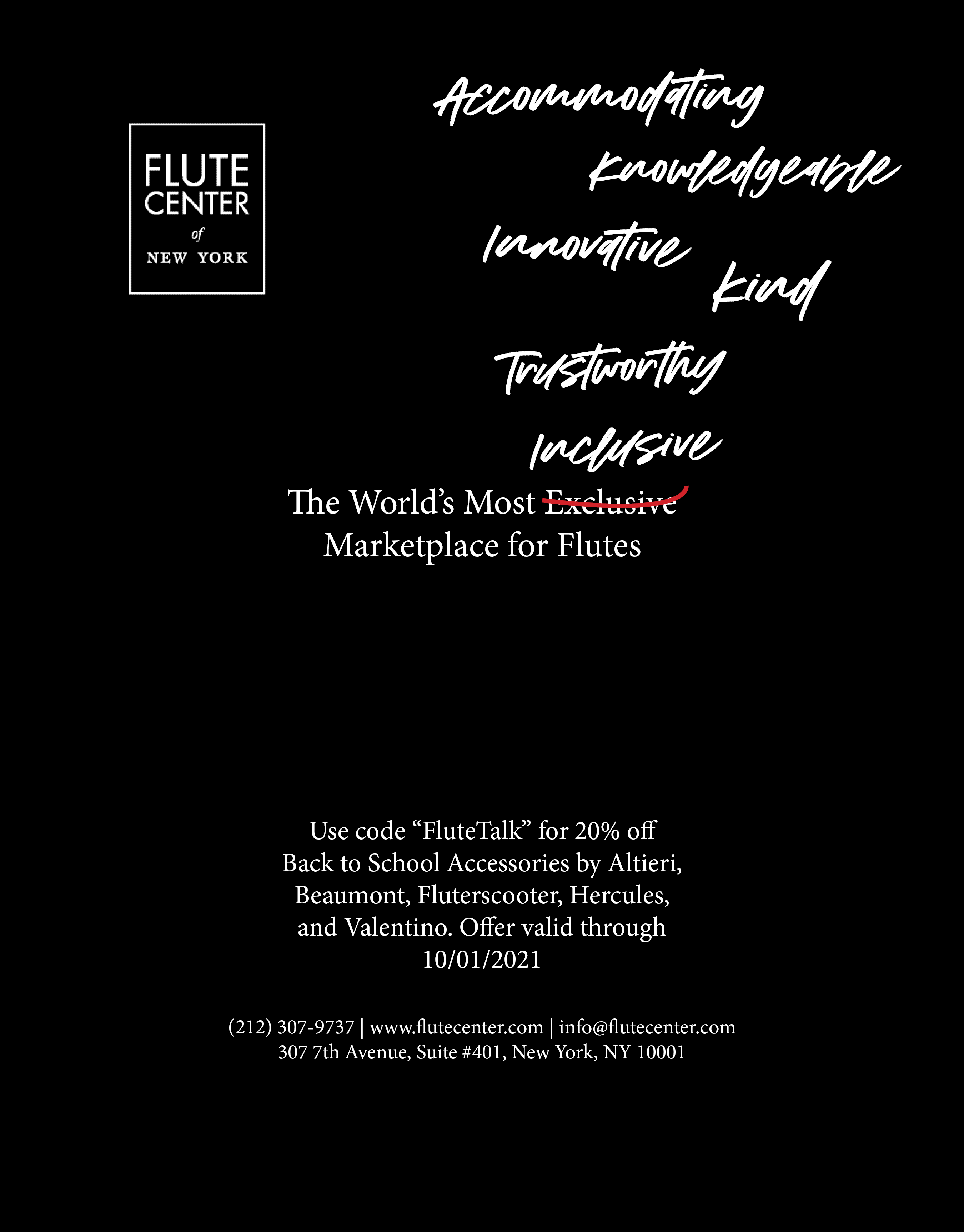Preparing to give high-pressure performances is a process many flutists experience throughout their careers. This can be an incredibly revealing and rewarding process, allowing an opportunity to discover many things about yourself as a musician and person. This past fall, I performed the Trail of Tears Concerto for Flute and Chamber Orchestra by Michael Daugherty with the Manhattan School of Music Chamber Sinfonia. This performance was by far the most nerve-wracking performance of my life, but it was also one of the most incredible experiences. It served as a true test of my ability to control my thoughts and commit to positivity throughout my preparation process.
During this process, I had to navigate a lot of negative thoughts. Over the past few years, I’ve spent much of my time trying to manage common feelings of fear, self-doubt and insecurity that nearly all flutists experience at some point throughout their careers. I began researching effective memorization strategies and practicing them through trial and error the summer before this performance. I failed a lot during this process, but these failures led me to discover an incredibly reliable and effective method of preparation that I will continue to use. The final performance of this piece was incredibly successful, and something I am very proud of.
After spending months working closely with my private teacher, Linda Chesis, and performing this piece in a masterclass for Christina Jennings, I was encouraged to try out the “positive visualization” method of preparation. At this point, I had already put in a great amount of memorization work through score studying and individual practice. I had performed movements of this piece from memory and had given one full run-through for an audience. Before I implemented this element of mental preparation, I was unable to make it through a complete run through of this piece from memory for an audience without feeling extremely uncomfortable or having at least one memory slip. My greatest challenge was overcoming self-doubt, and this positive visualization method allowed me to work through my fears and insecurities rooted in performance anxiety.

One Month Prior
Beginning 30 days before my performance, I started to set aside 20 minutes each day to conduct one positive visualization of myself performing this concerto. A positive visualization is a form of meditation that includes visualizing something you want, seeing it, feeling it, and believing it. For musicians, this involves visualizing all aspects of a performance or audition in as much detail as possible from start to finish. These visualizations can be done sitting in a comfortable position or lying on your back. They can be done with your eyes open in a soft gaze or closed. I recommend picking a time of day that you feel most energetic to conduct your visualizations. For me, this was in the morning before my first class of the day. It is crucial to leave enough time for this visualization so that you do not feel rushed. Feeling rushed may compromise your ability to focus which is the most important part. I chose to conduct most visualizations away from my flute so that I could really test my memory with each and every note of this piece and not be tempted to play along.
I began each positive visualization in a comfortable and quiet place in my room and closed my eyes, beginning by visualizing how standing backstage would feel before I walked out in front of the audience for this concerto performance. Since I was performing in the Manhattan School of Music’s Neidorff-Karpati Hall, I was fortunate to have a good mental image of how this hall looked and felt as it served as the home of all orchestra rehearsals and concerts. This allowed me to visualize the backstage area in great detail. If you are beginning a positive visualization, and you do not know how the backstage area looks, you can imagine a generalized version of a backstage area. If you are able, search online for a picture of the hall and the backstage area or consider reaching out to a personnel manager to ask if they can describe the stage for you.
After becoming visually comfortable backstage, I imagined myself walking out to the center of the main stage with confidence in the exact shoes and dress that I was planning to wear for the performance. This element of the visualization is incredibly important, especially if you have not yet performed in the outfit you plan to wear. I imagined myself greeting a full audience and smiling at them, thanking them all for being there. At this point, I began to feel waves of self doubt entering my mind. I noticed my mind beginning to convince myself that I would have a memory slip or make a mistake, causing the audience to boo me off the stage. Each time this happened, I would acknowledge this thought and tell it “no,” immediately following with a positive counterthought such as “I am excited to share this work I have done with the audience” or “I feel prepared and confident to give the best performance of my life.” Acknowledging and shutting down negative thoughts proved to be difficult at first, but the more I did it during mental visualizations, the more effectively I was able to do so during my physical run-throughs.
During the first two weeks I conducted my visualizations while listening to Amy Porter’s incredible recording of the Trail of Tears Concerto since I had not yet had the opportunity to work with the orchestra. It was important for me to continue hearing the orchestrated version in order to aurally memorize where the different parts of the accompaniment would switch instruments. When preparing for a concerto performance, it is helpful to know where each new sound is coming from in the orchestra so that you are prepared for these differences from the piano reduction during the first rehearsal. Being able to sing the flute melody in your head as you are playing adds an additional level of security to your memorization, and spending this time listening to this recording improved my overall level of understanding and connection to the piece.
After I visualized myself walking out confidently in front of the audience, I turned on the recording on my phone and imagined myself playing it from start to finish, deciding how I would use the time in between movements and the time I had onstage when I was not playing. Positive visualizations take an incredible amount of focus and concentration, something that proved very difficult at first. Starting this process 30 days before the performance gave me enough time to develop this level of concentration so that it was resilient by the time I stepped in front of the audience.
Two Weeks Prior
I stopped listening to the recording during my daily positive visualizations two weeks before the date of my performance. The first few attempts after removing this element provided many new challenges, but it also helped me to level up in my preparation. My daily visualizations now became a test of my memorization of the orchestral accompaniment and generating a deeper understanding of how my solo part fit into the overall piece. This step forward included a much higher level of concentration as I no longer allowed myself to have a solid recording to rely on. I experienced days where I had complete memory slips in my visualizations and was unable to keep going. When these memory slips happened in my visualizations, I made a mental note to go back and work on this spot later, but I also forgave myself and told myself, “these things happen, and it does not define your worth as a musician.” As soon as I completed the visualization, I took out a hard copy of my score to study and mark that specific part to prioritize it in my next practice session.
Experiencing all of these memory slips during my visualization process strengthened my confidence overall. The memory slips never occurred in the same place, meaning that I was working through all of the possible pitfalls I might have, decreasing my chances of having memory slips in the actual performance. I identified and strengthened all of the spots I was least comfortable with. I have learned to love failure as a part of the learning process. If you never fail, that means you are never allowing yourself to take risks and push your boundaries.
One Week Prior
I started to experience physical symptoms of nerves and performance anxiety one week before the performance. Rehearsals with the orchestra had begun, and although they were going really well, I was experiencing a loss of appetite, constant jitters and a general inability to focus. My daily positive visualizations helped me work through how to handle these symptoms and center my mind. The mental and physical preparation I had put in both on and away from my instrument provided a vital safety net during times of low energy and focus levels, and the meditative component of these daily positive visualizations provided me with an ability to calm myself down during times of high energy and anxiety. Although my mind continued to jump to all of the “what ifs,” I was able to effectively acknowledge these negative thoughts, counteract them, and re-center to a positive and confident mindset.
This week posed unique challenges that I had prepared myself for during my visualizations. In the hall that I was performing in, there are multiple windows on the back doors that allow you to see people walking by in the hallway, sometimes stopping to watch you perform through the glass. Some people even walked in and out during the dress rehearsals and recorded bits of my playing. I asked friends and colleagues to sit in on the dress rehearsals so that I could better visualize faces of people I may see during my performance, which was incredibly helpful and supportive of them. Although I thoroughly prepared for all of these possible situations to occur throughout my daily visualizations, it was helpful to experience everything in person and greatly improved the details of my positive visualization the next day.
Day of Performance
The day of my concerto performance of Trail of Tears began with a dress rehearsal with the orchestra. After thoroughly warming up on my instrument, I actively chose not to do a visualization in the morning because I wanted to give myself one last chance to test my memorization without my usual safety net. During the dress rehearsal I felt calm and confident, and I used my positive visualization skills to visualize myself wearing the dress and shoes I had chosen for my performance later that evening while I was physically playing with orchestra. I welcomed any and all distractions. During this run-through, people were coming in and out of the hall with cameras, taking photographs and recordings to post on the Manhattan School of Music social media accounts. I convinced myself that if I was able to fully concentrate through all of this, then I was set for nearly anything that may happen during the performance. I left the dress rehearsal feeling confident and I tried to manifest positivity for the remainder of the day by putting away my flute and focusing on the present.
This plan worked for a few hours until the usual symptoms of performance anxiety began to settle in. I took the afternoon to greet my family that came in town for this performance to take my mind off of things, and then I returned to my room three hours prior to the performance to make sure I ate a nutritious meal, drank water, and gave myself time to re-center. My piece was scheduled at the very end of the concert, so I also had to account for the time that I would have sitting backstage in a dressing room. An hour and a half prior to the beginning of the concert, I took my dress and makeup into the dressing room and began to get ready. This left one hour during the concert to make any final mental preparations. I found myself pacing back and forth in the dressing room, growing increasingly distracted and anxious. I took this time to go through one final positive visualization, and this one proved to be the most difficult and the most important. Since the performance was so close, I made sure to incorporate the energy and passion I wanted to share with the audience into this visualization. I also recited positive mantras to myself throughout including “I am prepared,” “I am confident.” “I am excited to give this performance.” This final visualization helped me to center and quiet my mind, focusing all of my energy on giving the best performance of my ability.
As it became time to wait backstage, my heart was pounding and I noticed feelings of self-doubt starting to creep in again. I was able to acknowledge these thoughts and let them go because I was used to doing so every time they would appear throughout my daily visualizations. Once I was on the stage, I felt in control and confident. I was able to effectively manage and play confidently through any minor mistakes that happened, and I experienced an overwhelming feeling of connection to the audience throughout. I was truly able to let go and trust my preparation.
This performance was one of my most successful performances to date, and I credit most of this success to all of the mental work I did in preparation. Prior to this performance, mental work played a minor role in my preparation process for auditions, competitions and performances. I now realize how important mental preparation is for all musicians, especially if you frequently experience performance anxiety like I do. Positive visualizations can benefit musicians in any setting including orchestral auditions, school placement auditions, competitions, and any type of performance. The most important thing is committing to the details during these visualizations and acknowledging any negative thought that may come up and counteracting it with a positive one. The more you continue doing these positive visualizations, the more confident you will become with your playing. This mental preparation allows you to work through any insecurity and self-doubt you may experience and come out as a resilient flutist on the other side.

.jpg)






